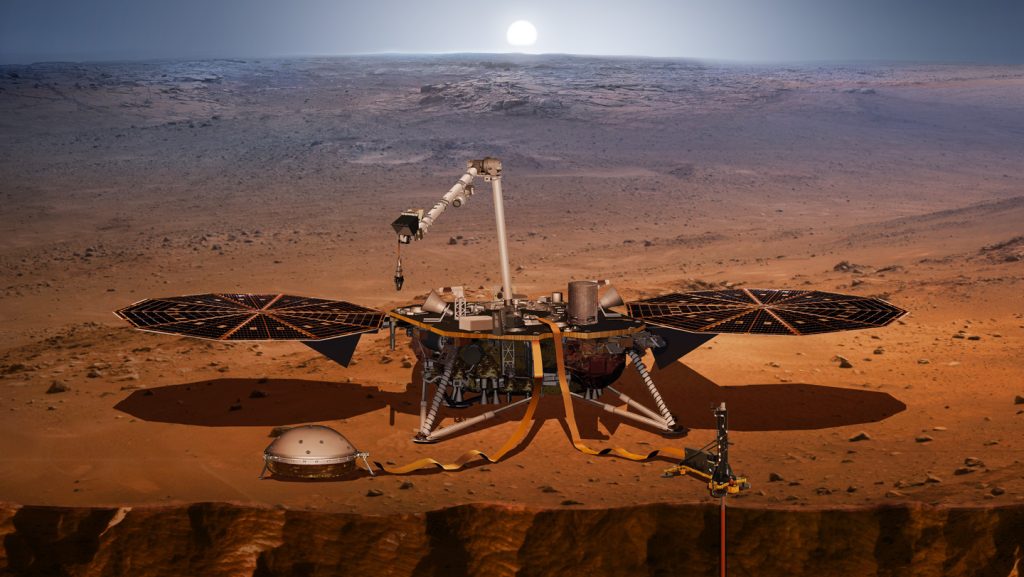InSight’s Martian Discoveries: A Journey Into the Red Planet’s Heart
Mars has always been a planet of mystery and fascination. For centuries, humans have gazed at its reddish glow in the night sky, wondering what secrets it might hold. In recent years, NASA’s InSight lander has provided unprecedented glimpses into the Martian interior, transforming our understanding of this neighboring world. For four years, this remarkable spacecraft sat quietly on the dusty Martian surface, its sensitive seismometer feeling the subtle vibrations of the planet—marsquakes that traveled through the planet’s layers, carrying information about what lies beneath. What InSight revealed was stunning: Mars likely has a solid inner core, a discovery that challenges previous models and adds a new chapter to our understanding of planetary formation in our solar system.
The journey to this discovery was no simple feat. When InSight (Interior Exploration using Seismic Investigations, Geodesy and Heat Transport) touched down on Mars in November 2018, it marked the beginning of the first mission dedicated primarily to studying the deep interior of the Red Planet. Unlike rovers designed to travel and explore the surface, InSight was built to stay in one place and listen deeply. Its primary instrument, a seismometer called SEIS (Seismic Experiment for Interior Structure), was so sensitive it could detect movements smaller than the width of a hydrogen atom. Protected by a dome shield against Mars’ harsh winds and temperature fluctuations, SEIS began recording the subtle tremors that periodically shook the planet. Each marsquake sent seismic waves through different layers of the planet, and by analyzing how these waves traveled, scientists could begin to piece together Mars’ internal structure—much like how medical ultrasounds create images of our bodies.
What made this research particularly challenging was the relative quiet of Mars compared to Earth. Our planet experiences thousands of detectable earthquakes every day, but Mars is much less seismically active. The InSight team had to patiently wait for significant marsquakes, carefully distinguishing them from other vibrations caused by Martian weather or the lander itself. Over its mission, InSight detected over 1,300 marsquakes, ranging from minor tremors to more substantial events. The most valuable data came from larger quakes, whose seismic waves penetrated deeper into the planet. Scientists were particularly interested in what are called “core shadow zones”—areas where certain types of seismic waves are blocked or altered by the core. By carefully analyzing how waves traveled through Mars, researchers began to build a clearer picture of the planet’s layered structure: a crust, mantle, and core—but with some surprising differences from Earth.
The most remarkable revelation was about Mars’ core. Prior to InSight, scientists generally believed Mars had a liquid iron core, similar to Earth’s outer core. However, the seismic data suggested something unexpected—Mars appears to have a solid inner core surrounded by a molten outer layer. This finding came from analyzing how seismic waves, particularly S-waves (shear waves), traveled through the planet. S-waves cannot pass through liquid materials, so their behavior provided crucial clues about the core’s composition. The solid inner core appears to be about 500 kilometers in radius, smaller than Earth’s inner core relative to the planet’s size. This solid core is rich in sulfur and other light elements, giving it different properties than Earth’s predominantly iron-nickel inner core. This discovery has profound implications for understanding Mars’ evolution, including how its magnetic field disappeared billions of years ago, leaving the planet vulnerable to harsh solar radiation that likely stripped away much of its atmosphere.
Mars’ solid inner core tells a story of planetary cooling. Billions of years ago, Mars was a much more Earth-like world, with flowing water on its surface, a thicker atmosphere, and possibly even a global magnetic field generated by a dynamic core. But being smaller than Earth, Mars cooled more rapidly. As it cooled, its core began to solidify, and the convection processes that would have driven a strong magnetic dynamo weakened and eventually stopped. Without this protective magnetic shield, the solar wind gradually stripped away Mars’ atmosphere, transforming it into the cold, dry world we see today. The solid inner core discovered by InSight is like a fossil record of this cooling process, frozen in time. Understanding this process helps scientists piece together not just Mars’ history, but potentially the future of all rocky planets as they age and cool. It raises questions about Earth’s distant future and provides context for studying exoplanets around other stars.
InSight’s mission officially ended in December 2022, when dust accumulation on its solar panels prevented it from generating enough power to continue operations. In its four years of service, this stationary lander revolutionized our understanding of Mars, providing the first detailed look beneath the surface of another planet. The discovery of Mars’ likely solid inner core stands as one of its greatest achievements, a finding that will influence planetary science for decades to come. As we continue to explore Mars with other missions like Perseverance and Curiosity, and as we look forward to eventually sending humans to the Red Planet, InSight’s revelations provide crucial context about the world we’re exploring. Mars is not simply a smaller version of Earth but a unique planet with its own evolutionary path—a path now better understood thanks to a quiet lander that spent four years listening to the beating heart of our neighboring world.


